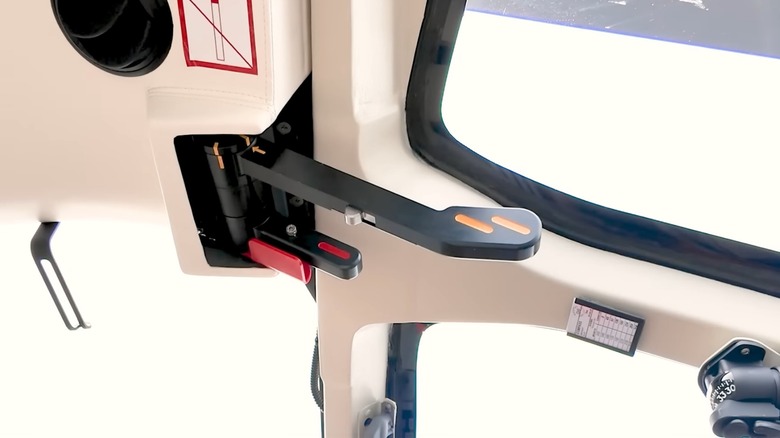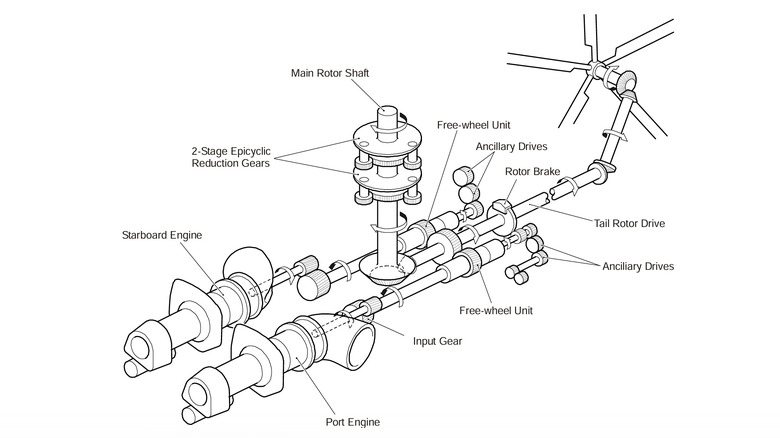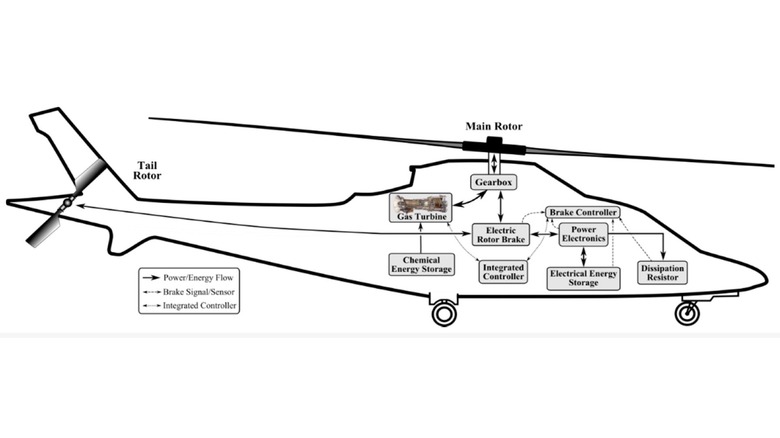The Very Real Danger Behind This Helicopter Lever (And What It's For, Explained)
In 2023, a terrifying video went viral on social media in which a passenger seated next to a helicopter pilot attempted to pull a lever. The move is clearly a major safety hazard, as passengers are advised to steer clear of any controls and buttons in the cockpit, let alone ignore the pilot's warnings. "That will kill us," the pilot yelled after shrugging the person off a few times. The incident got coverage in mainstream media, and numerous theories were spawned to explain what the lever actually does and why it is so risky to pull it during a flight.
Well, that lever mounted to the ceiling is a rotor brake. The rotor assembly, which includes the blades, rotates to provide the necessary aerodynamic lift that allows helicopters to take off, fly, hover, and then land safely. In a nutshell, if you slow or shut down the rotor blades, the helicopter will no longer be able to maintain its flight. Depending on its height above the ground, the uncontrolled descent due to non-spinning rotors will most likely end up in a catastrophic accident (though there's one myth about crashes you shouldn't believe).
According to Independent Helicopters, which offers pilot training and runs a certified flight school, the brakes "stop the rotor from spinning." They are usually applied after shutting down the engine once the helicopter has landed. However, applying them is not mandatory because when you cut down the power supply from the main engine, they naturally slow down and come to a halt.
What is the main role of this lever?
An expert at Eurosafety International, which offers pilot training services, gave a demo of how the rotor brake lever works and explained that it's not exactly a straightforward procedure. You can't directly pull the lever back — you first have to engage the release mechanism using a switch at the back. If someone tries to pull the crank back without pushing the release switch, it won't move from its position. "In order to engage the rotor brake, you actually have to bring it all the way back and lock it," the expert said. "There's no way you'd have the force necessary in order to make that happen."
According to the Rotorcraft Flying Handbook released by the U.S. government's Federal Aviation Administration, the primary role of the lever-style brake is to slow down the rotor activity after landing and keep the blades in check during storage. The latter is a crucial safety consideration. "A parked gyroplane should never be left with unsecured blades, because even a slight change in wind could cause the blades to turn or flap," the manual reads.
It further notes that the brakes should be applied when the blades are spinning relatively slowly, somewhere under around 75 rpm. As per another flight manual issued by the British Royal Air Force's Central Flying School, the rotor brakes rely on a hydraulic system to control the rotor assembly. They are either drum or disc-type, similar to cars.
It's a last-mile rescue lifeline
So far, we have only discussed the role of rotor brakes from an operational perspective. But they play a critical part in a particularly risky scenario where helicopters can literally be torn apart within a matter of seconds. That unprecedented hazard scenario is called ground resonance. It happens due to violent oscillations of the rotor assembly (which contains the "Jesus nut"), and these eventually interact with the vibrations originating from the main body and reach a critical level where the components violently fall apart.
As expected, the best way forward would be to somehow control these vibrations. Naturally, the best way to avoid the impact of ground resonance is to avoid them altogether. One strategy is to instantly take off and lose contact with the ground. But if that's not possible, helicopter pilots are advised to "apply the rotor brake to maximum and stop the rotor as soon as possible." Usually, when a helicopter is about to take off, a small vibration is felt — the result of natural ground resonance. But it's only when the oscillations amplify that things escalate to dangerous levels.
For such unprecedented situations, the lever should be immediately pulled in order to apply the rotor brakes. In addition to applying the rotor brakes with urgency, the helicopter pilot should also dial down the throttle and shut down the engine to minimize the vibrations. To sum it all up, if you are a passenger in a helicopter, stay away from touching the rotor brake lever, especially during an active flight.


